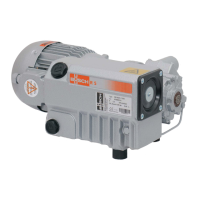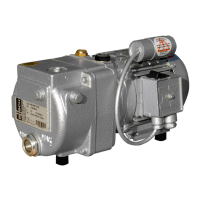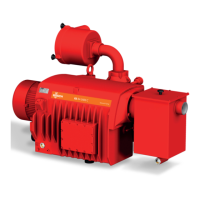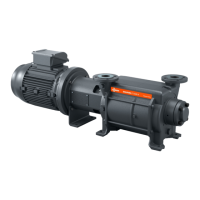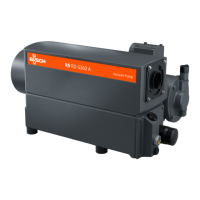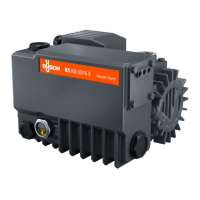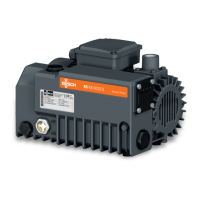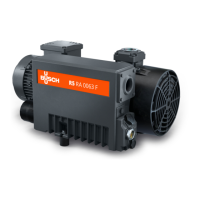7
If the oil temperature is too severe, Busch R570 (syn-
thetic) or R590 (semi-synthetic) oil should be used to
withstand the elevated temperatures. If synthetic oil is
used, the pump should be flushed with Busch R568 oil.
Contact the factory for instructions on the flushing pro-
cedure. Auxiliary oil cooling is the most practical
approach to a severe heating problem.
Contaminated Air Stream
When the air stream contains a solid and/or liquid that
can contaminate the oil, it must be changed more often.
If the air stream contains a small percentage of con-
taminates and/or they are slightly aggressive* (mild
acids, etc.), synthetic oil, such as Busch R570, will
resist breakdown better than the standard Busch R530.
The solution is to install a filter or knock-out pot to keep
the contaminates out of the pump.
*Process air streams with a large percentage of contaminates and/or
more than slightly aggressive contaminates must use a chemical duty
pump.
Oil change intervals can only be established by experi-
ence with the pump operating in the actual conditions
(see previous paragraph for some of the conditions).
Develop the oil change interval by periodically checking
an oil sample removed from the pump. When the oil
sample has become dark in color (from solids and car-
bonized particles) or is milky looking (from water), it is
time to discard it. As mentioned before, a thorough
flushing may be required.
3.1.4 Oil Flushing Procedure
Flushing is needed under certain conditions. Some
pumps will be beyond flushing and will need to be over-
hauled.
To help determine if flushing is needed, observe the
condition of the oil as it is drained from the pump. Is it
black and tar like or contaminated in any way? Was the
pump noisy, overheating, or was the motor overload
shutting the pump off? How old is the pump and when
was the last time the oil was changed?
If the above conditions exist or you don't know when the
last oil change was performed further investigation is
needed. Also, when changing from one oil type such as
R530 to another type such as R590 or R570 it will be
beneficial to flush. Although the oils are compatible,
mixing a lesser grade oil such as R530 with a synthetic
oil like R570 will reduce the effectiveness of the syn-
thetic oil.
All of the oil will be removed and replaced with the
flushing oil (Busch R-568), and eventually that will be
replaced by whatever Busch oil is needed for your par-
ticular application. Have enough oil and oil filters on
hand for a couple of flushes. The following describes
the steps in the flushing procedure:
Shut the pump off and drain all the oil from the pump
and remove the access plates (Ref. 205) from the
exhaust box (Ref. 075). Remove the metal baffle (Ref.
078) and take a good look at the internal walls of the oil
sump. If the walls are discolored but have no build up
of any kind one can proceed with the flushing. If gelled
or burnt oil is clinging to the walls this material must be
scraped and removed prior to flushing. Proceed by
scraping and cleaning as much of the exhaust box as
possible. The more debris that is removed now the
more effective the flushing will be later. Re-install the
metal baffle, cover and proceed with the flushing. At
this point one must remember that the oil lines and oil
cooler might also be plugged to a point where no
amount of flushing will make a difference and a com-
plete overhaul will be the only option. Depending on
the severity of the oil contamination flushing may be a
last ditch effort.
Drain all of the oil from the pump. The more contami-
nated oil you remove now the more effective the oil
flushing will be.
Remove the oil filter (Ref. 100) and install a new one. It
is recommended that you do not change the exhaust fil-
ter or filters until after the flushing to prevent contami-
nation of any new filters.
Fill the exhaust box with the proper amount of flushing
oil (Busch R-568).
If possible run the pump with the inlet closed and off of
the process. Run the pump for approximately six hours,
shut the pump off and drain a small sample of oil into a
clear container.
Examine it. If it is clear to amber run the pump for
another six hours and examine it again. If after the first
six hours it is black drain it and fill again using another
new oil filter.
If after the second flushing the oil still remains black the
pump may have too much contaminated oil in it to flush
out properly. There may be residue remaining in the
lines and cooler that will not flush out. An overhaul will
be necessary.
If after the second six hour period the oil still remains
clear to amber in color drain it, change the oil filter and
fill with the regular oil. At this point also change the
exhaust filters.
Run the pump with a fresh charge of the oil to be used
in your application (not R-568), and monitor the operat-
ing conditions closely. Check for noise, overheating
and oil condition until a regular oil change schedule can
be established.

